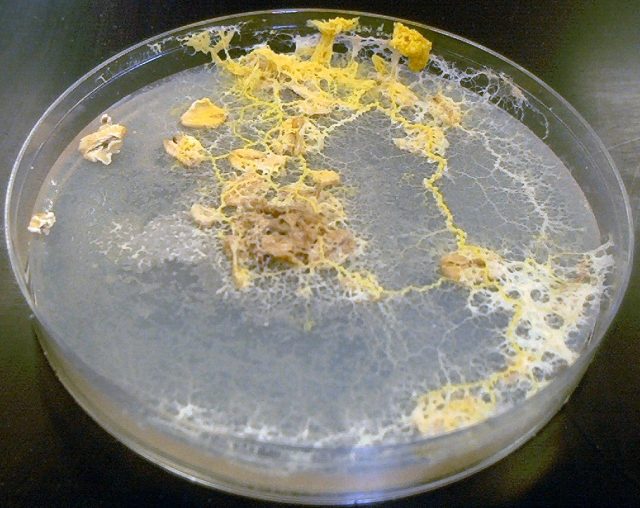
Is it possible to know where you've been when you don't have a brain? Depending on your definition of "know," the answer may be yes. Researchers have shown that the slime mold, an organism without anything that resembles a nervous system (or, for that matter, individual cells), is capable of impressive feats of navigation. It can even link food sources in optimally spaced networks. Now, researchers have shown it's capable of filling its environment with indications of where it has already searched for food, allowing it to "remember" its past efforts and focus its attention on routes it hasn't explored.
And it does this all using, as the authors put it, "a thick mat of nonliving, translucent, extracellular slime." As you might expect, given the name.
Slime molds are odd creatures: organisms that have a nucleus and complex cells, but are evolutionarily distant from the multicellular animals and plants. When food is plentiful, they exist as single-celled, amoeba-like creatures that forage on the food. But once starvation sets in, the cells send out a signal that causes them to aggregate and fuse. This creates an organism that's visible to the naked eye and all a single cell, but filled with nuclei containing the genomes of many formerly individual cells. That turns out to be advantageous, because this collective can move more efficiently, and go about foraging for food. In the course of this foraging, the organism leaves behind a trail of slime.
In the course of studying the slime mold, some researchers noticed that the slime mold would avoid any areas covered in slime. So they decided to quantify that. They set up two equal food sources at both ends of a Y-shaped container, and put some slime mold at the base. One of the arms had plain media for the organism to crawl across; the other coated the surface of the media with slime. The results were dramatic: in 39 of the 40 tests they ran, the slime mold avoided the arm that was pre-slimed.
Based on this finding, the authors hypothesized that the mold "uses its [the slime's] presence as an externalized spatial memory system to recognize and avoid areas it has already explored." So, they came up with a test that, in their words, "challenged our slime mold."
They created a three-sided box, and placed it with the open end facing a slime mold. Behind the box, the authors placed a tasty treat of glucose, which could slowly diffuse through the box. But the slime mold was unable to pass through the walls of the box, and thus couldn't take a straight path towards the food source. To find it, it would have to explore the interior of the box, give up, and start looking for a way around it.
Within a few days, 96 percent of them had. But, when the authors covered the entire setup in slime so the mold had no way of telling what areas it had already visited, only about a third of the organisms succeeded in making their way to the food.
So, the authors conclude, the slime isn't just the mold's calling card. Instead, it's a way of marking the environment so that the organism can sense where it's been, and not expend effort on searches that won't pay off.
Although the situation isn't an exact parallel, the authors make a comparison to the pheromone trails used by ants. (This comparison may have come about because two of the authors work in the Behaviour and Genetics of Social Insects Laboratory at the University of Sydney.) No individual ants have to remember where a food source is. Instead, by laying down a trail of scent molecules, workers that find food leave a trail in the environment the ants can collectively use. In effect, the colony has a memory that's stored in the environment.
In this case, the slime mold does the opposite, in that it avoids the areas of its environment that are chemically marked. The other big difference, of course—the slime mold doesn't have a brain at all. Still, the general principles of placing a memory in the environment are the same.
PNAS, 2012. DOI: 10.1073/pnas.1215037109 (About DOIs).
reader comments
42